21 Most Common Types of Butterflies in California
-
Pete Ortiz
- Last updated:
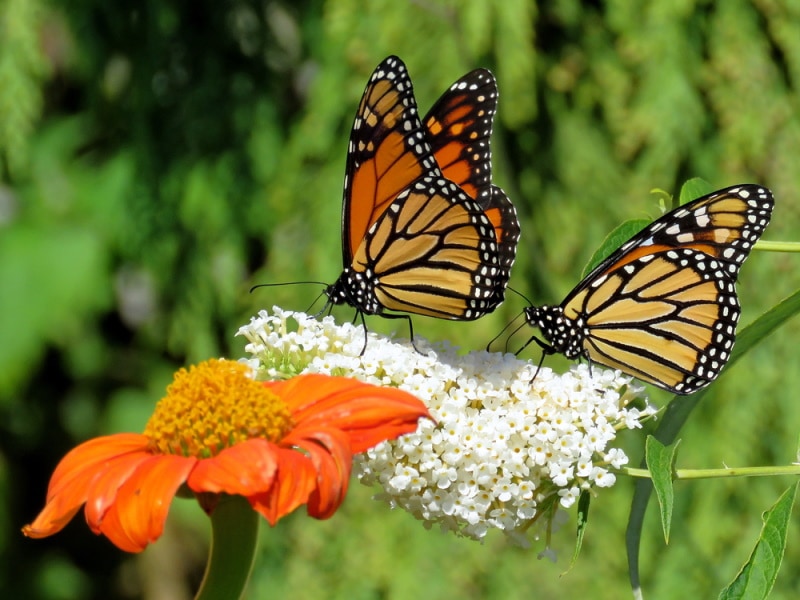
When you hear someone complain that they don’t like “bugs,” they seldom include butterflies in that category. The gentle, quiet winged insects are great fun to observe and (usually) beneficial to have around your yard too! California is home to hundreds of butterfly species, but here are 21 of the most common and unique types of butterflies in the state.
The 21 Most Common Types of Butterflies in California
1. Painted Lady
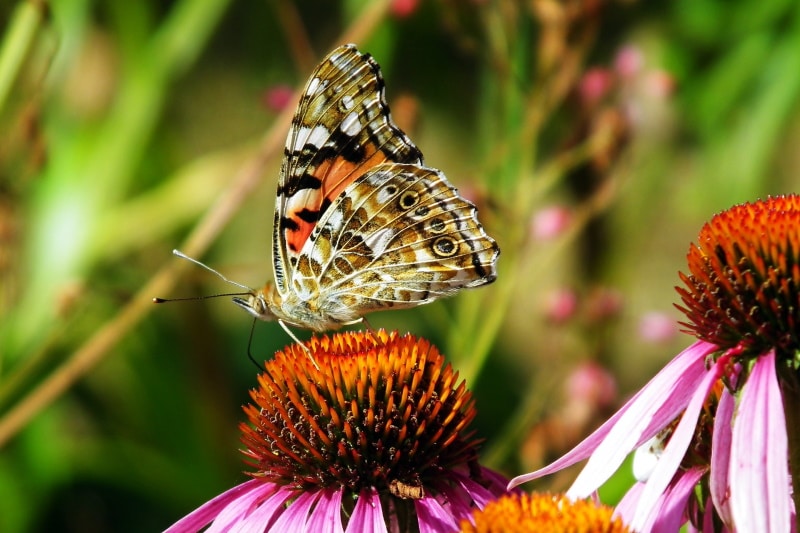
| Scientific name | Vanessa cardui |
| Wingspan | 1.6–2.9 inches |
The painted lady is one of the most common butterflies in North America. In California, they can be found in open, sunny areas. Painted lady butterflies migrate south to Mexico during the winter. Their migration pattern can be unpredictable, causing their population in specific areas to vary from year to year.
They have pink-orange wings with dark marks encircling white dots near the tips. The caterpillars are greenish yellow to dark gray, often with light spots. They feed on many plants and may damage some crops, like beans and mint.
2. Cabbage White
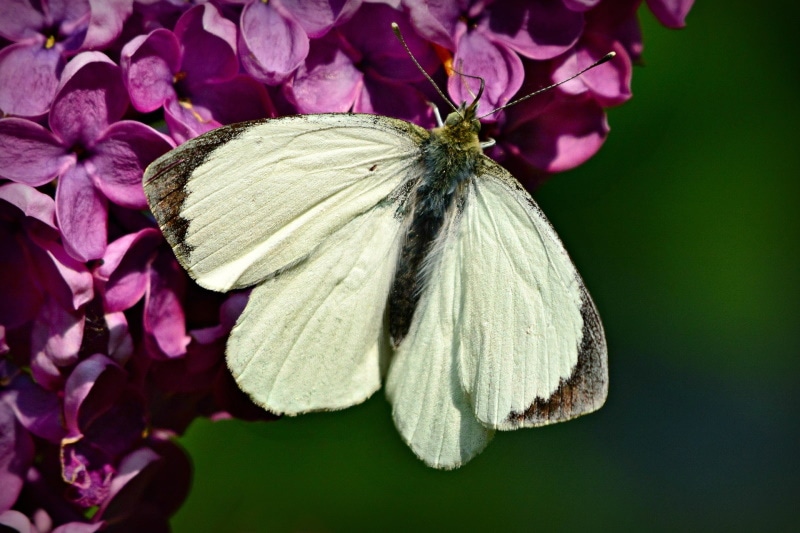
| Scientific name | Pieris rapae |
| Wingspan | 1.3–1.9 inches |
The cabbage white is considered an invasive species in California and is a known agricultural pest. These small butterflies are found in many parts of California, except in thick forests and high elevations. Their wings are white to light green with black wingtips and either one (males) or two (females) black marks on each side.
Their caterpillars are dark green with a light green back stripe. Cabbage white caterpillars commonly feed on garden vegetables, including cabbage, kale, cauliflower, and radishes, which can cause serious damage, especially in a state as reliant on agriculture as California.
3. Monarch

| Scientific name | Danaus plexippus |
| Wingspan | 3–4 inches |
Monarch butterflies are probably the most easily recognized of all species. Their striking orange and black wings are certainly memorable, but so is their story of long, yearly migrations.
Monarchs winter along the California coast and can be found anywhere that the milkweed plant is present. The caterpillars are colorful in their own right; they’re patterned in black, white, and yellow stripes. Monarch butterfly populations are in decline across North America. California residents can help by planting milkweed to help feed monarch caterpillars.
4. Red Admiral
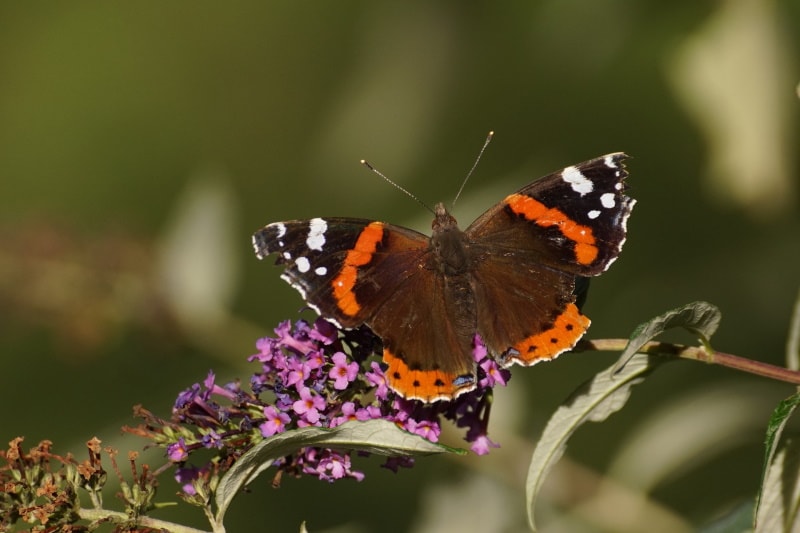
| Scientific name | Vanessa atalanta rubria |
| Wingspan | 1.75–3 inches |
Red admiral butterflies are found in most of California, often in yards and near wooded areas. They have dark brown wings with a distinct orange band across the upper portion and lining the bottom of the lower wings.
The upper wings also have black tips with white spots. The caterpillars have shades of gray, with white spots and spines covering their bodies. Red admiral butterflies are attracted by flowers and fermented fruit. They are fun butterflies to observe because they tend to be mellow around humans and frequently land on people they encounter.
5. Common Checkered Skipper
| Scientific name | Pyrgus communis |
| Wingspan | 0.75–1.5 inches |
Also called the white checkered skipper, the common checkered skipper is a small, speedy flier. They like low-lying habitats with semi-disturbed plant matter. Common checkered skippers are brown with a white checkerboard pattern covering their wings.
Their caterpillars are green with dark brown heads and white hairs all over their bodies. They feed on numerous plants, including hibiscus. Adults rest with their wings spread out instead of folded and feed on sunflowers and clover.
6. Western Tiger Swallowtail
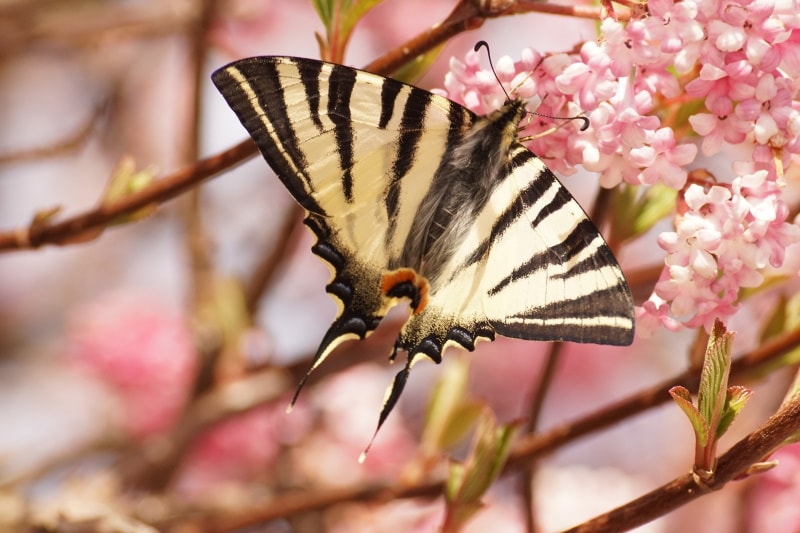
| Scientific name | Papilio rutulus |
| Wingspan | 2.25–4 inches |
As one of California’s biggest and most beautiful butterflies, western tiger swallowtails are found in gardens, fields, and open woods. They have striking yellow and black tiger-striped coloring, with signature long tails on the lower wings.
The caterpillars range in color from green to purple-brown and have distinct eye spots on the back of their heads. They feed on the leaves of various trees, including cottonwoods and willows. Western tiger swallowtails often frequent moist locations and gather around puddles to drink water.
7. Mourningcloak
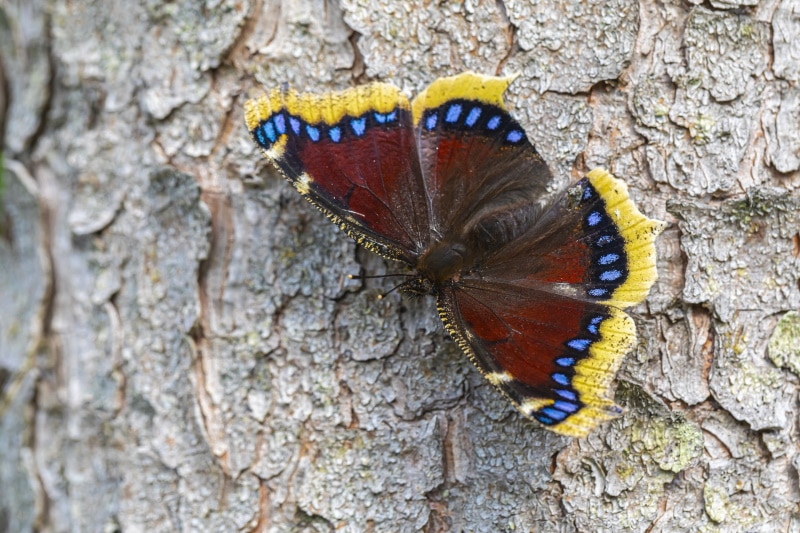
| Scientific name | Nymphalis antiopa aniopa |
| Wingspan | 3–3.5 inches |
Mourningcloak butterflies are widespread in California. They live in forest habitats as well as populated areas like yards and parks. They have dark wings with a yellow border and blue spots along the edges.
The caterpillars are black with white and red spots. They feed on the leaves of trees like willows and poplars. Mourningcloaks are more cold-tolerant than most butterflies. In Southern California especially, they can often be spotted year-round, although they tend to blend in well with their surroundings.
8. Common Buckeye

| Scientific name | Junonia coenia |
| Wingspan | 2–2.5 inches |
The common buckeye is found throughout most of California in open habitats like fields and roadsides. They’re colorful butterflies featuring brown wings decorated with orange stripes and multi-colored, dark-ringed eye spots on each side.
Common buckeye caterpillars are dark and spiny with stripes on the back and sides. They feed on many different plants and flowers. Male butterflies guard their locations against other insects, chasing them away when spotted. They tend to fly low to the ground, making them hard to see.
9. Cloudless Sulphur

| Scientific name | Phoebis sennae |
| Wingspan | 2–3 inches |
Cloudless sulphurs are beautiful, bright yellow butterflies found in Southern California. They are often seen near human developments, in yards and parks, making them one of the most easily recognized species in the state. The caterpillars are either green or yellow, depending on the kind of flowers they’re feeding on.
Their favorite plants are toxic, which makes the caterpillars poisonous to predators. Adult cloudless sulphurs feed mainly on red flowers. The population of these butterflies is declining in California, so planting flowers in their preferred color can certainly help attract them.
10. Mournful Duskywing
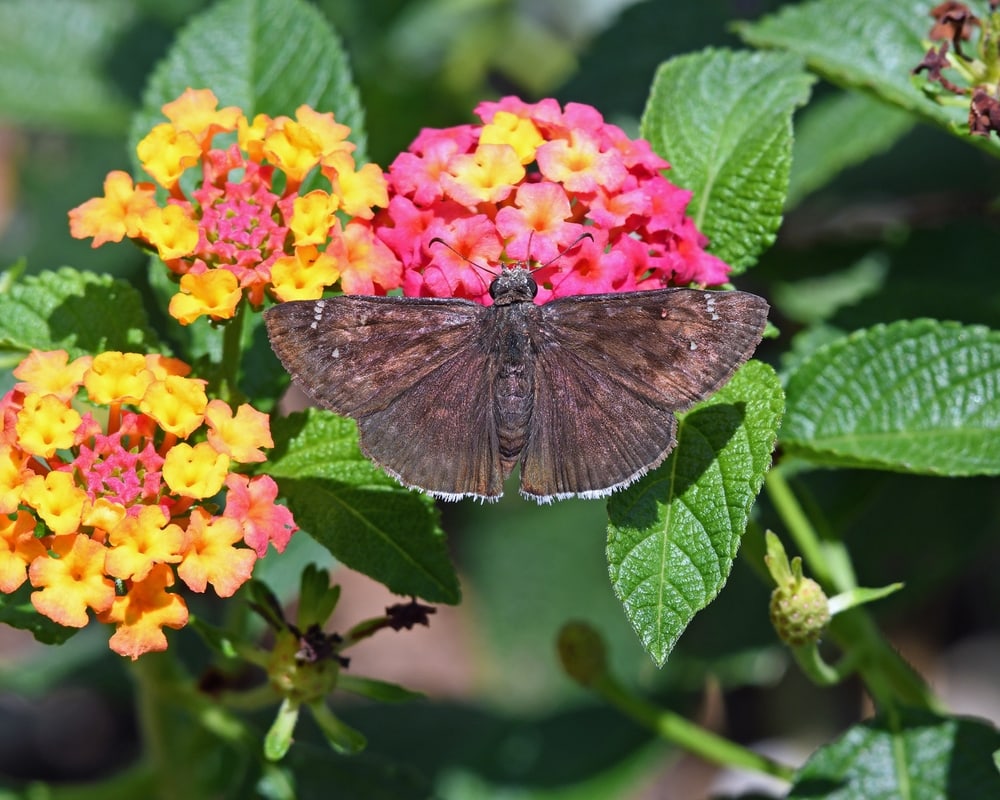
| Scientific name | Erynnis tristis |
| Wingspan | 1.25–1.75 inches |
The mournful duskywing looks very similar to another skipper-type butterfly, the funeral duskywing. Mournful duskywings have brown wings, a white fringe, and a few dark spots. Females have more prominent spots than males. They are small, fast butterflies that live in the northern areas and foothill regions.
The caterpillars feed primarily on oak leaves, which limits their distribution to wooded areas. In Southern California, they are mainly limited to live oaks. Adults feed on flower nectar.
11. Gulf Fritillary
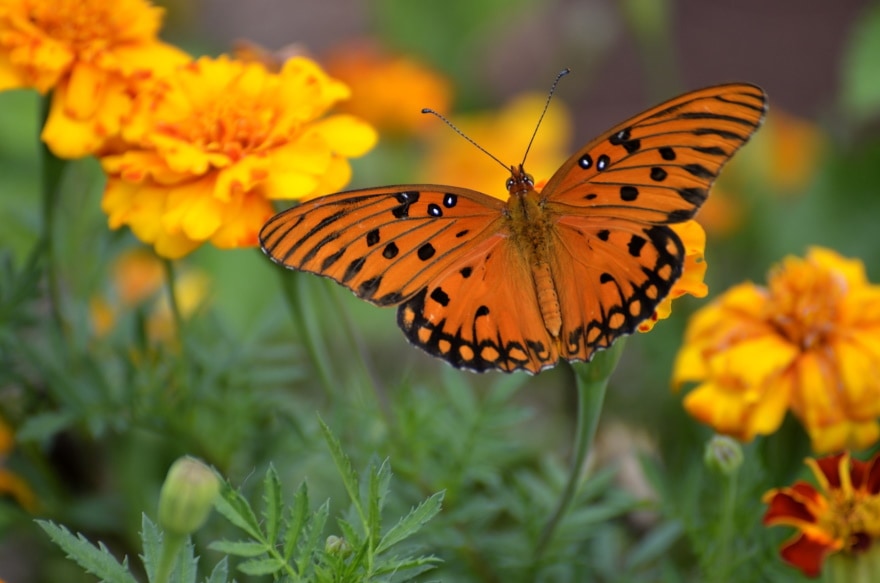
| Scientific name | Agraulis vanillae |
| Wingspan | 2.5–3.75 inches |
These gorgeous butterflies are found in southern parts of the United States, including Southern California. The gulf fritillary looks similar to a monarch from the top. However, the bottom of their wings is marked with silver spots, unlike the monarch.
The caterpillars are orange with black spines and feed on various passionflower species. These butterflies are commonly sighted in densely populated human areas, like cities and suburbs. Gulf fritillaries can’t handle cold weather well and will only stay year-round in areas where freezing temperatures rarely occur.
12. California Tortoiseshell
| Scientific name | Nymphalis californica |
| Wingspan | 1.25–2.75 inches |
California tortoiseshell butterflies are found in the hilly and mountainous regions of the state. They have orange wings, with some black spots and a brown border. The edges of their wings are bumpy instead of smoothly rounded.
California tortoiseshells rest with their wings folded, and the underside of their wings is a dull brown pattern, allowing them to blend in with the leaves around them and hide. The caterpillars are black with white hairs and spots. This species goes through varying population cycles.
13. Satyr Comma
| Scientific name | Polygonia satyrus |
| Wingspan | 1.75–2.5 inches |
The satyr comma is found throughout California in wooded, shady habitats. Their wing edges are rough instead of smooth and are light brownish-yellow in color, with dark spots and rims. The underside of their wings is a plain brown pattern, allowing the butterflies to camouflage themselves among the leaves when at rest.
Their caterpillars are black, with a white stripe down the back and orange spots on the sides and spines. They feed primarily on nettle plants. Satyr commas are fast fliers but don’t tend to go long distances when they take to the sky.
14. American Lady
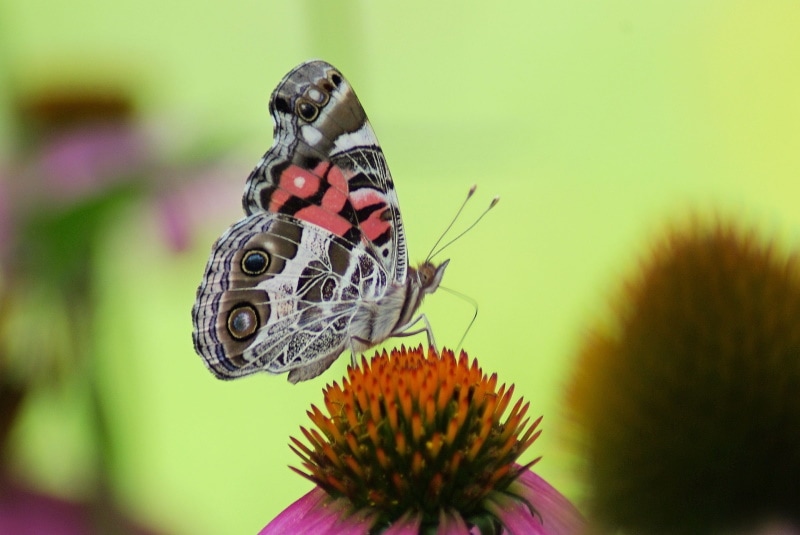
| Scientific name | Vanessa virginiensis |
| Wingspan | 1.75–2.75 inches |
American lady butterflies have some of the most exciting color and pattern combinations. The upper side of their wings is orange, with black stripes and wingtips spotted with purple and white.
Underneath, the dark brown wings are marked with a unique white cobweb pattern, pink bars, and several large eye spots. The caterpillars are dark and spiny. The American lady is found throughout California in open habitats full of flowering plants.
15. Pearl Crescent

| Scientific name | Phyciodes tharos |
| Wingspan | 1.25–1.75 inches |
The pearl crescent is a small butterfly found in Southern California. They frequent moist habitats, including open fields, gardens, and forest edges. Pearl crescents have orange wings covered in an intricate black lace pattern.
Females are larger than males. The caterpillars are spiny, dark brown with white stripes. Both caterpillars and adult butterflies like to feed on Aster plants, and the adults serve a role as pollinators. Pearl crescent butterflies often swarm into puddles and muddy ground.
16. Common Wood Nymph
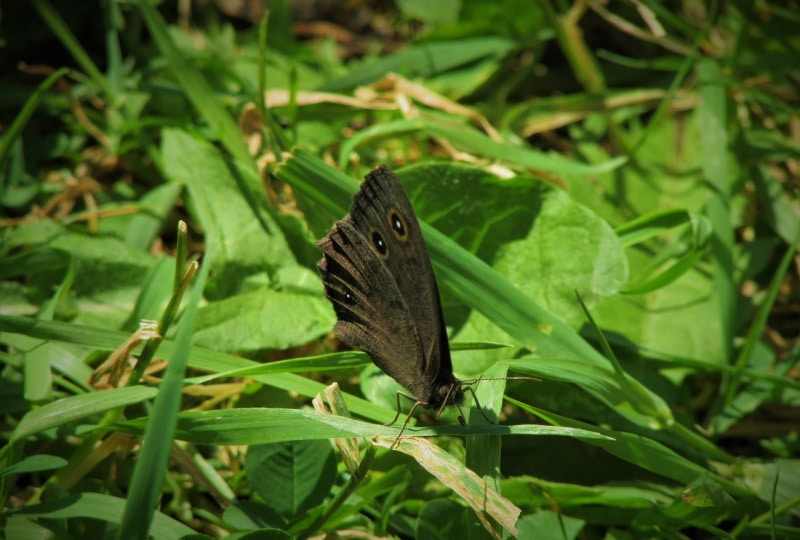
| Scientific name | Cercyonis pegala |
| Wingspan | 1.75–3 inches |
The common wood nymph is found primarily in Northern California across multiple habitats, from forests to salt marshes. Adult common wood nymphs are usually brown with darker eye-spots on each wing. However, there is some color variation.
The Caterpillars are yellowish green, with darker green stripes and white hairs. They are one of the few caterpillars that feed on grass rather than leaves or flowers. Adult common wood nymphs like to feed on decaying fruit or plants but will drink nectar if those are not available.
17. American Snout
| Scientific name | Libytheana carinenta |
| Wingspan | 1.25–2 inches |
American snouts are named for their long, beak-like noses, which help keep them camouflaged at rest. The top of their wings is brown with orange and white patches. However, the underside is more of a grayish-brown and resembles a dead leaf.
The caterpillars are green with yellow stripes and feed on leaves. The American snout is not seen as often in California but may be spotted in the southern part of the state. These butterflies migrate in huge flocks, sometimes even making the news in certain parts of the country.
18. Echo Blue
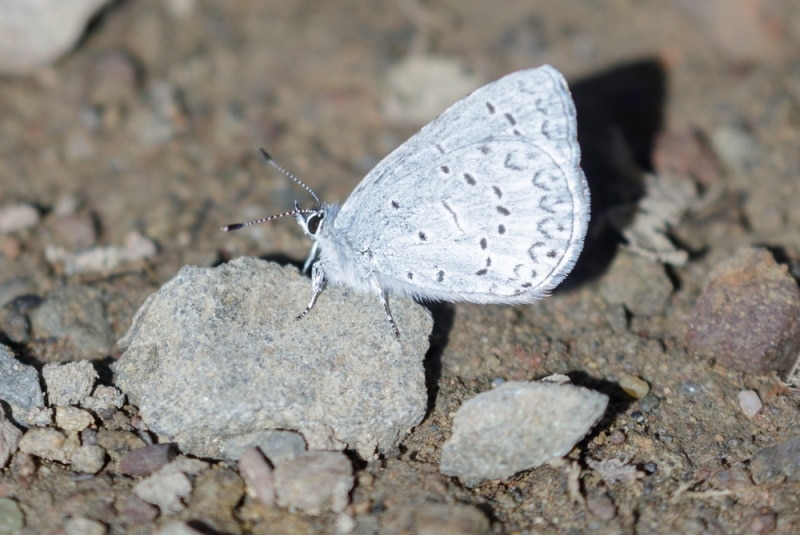
| Scientific name | Celastrina argiolus |
| Wingspan | 2–3 inches |
Also called the echo azure, this beautiful butterfly is found in wooded areas throughout California. The blue echo has silver-blue wings with a black-and-white edge. Underneath, they are light gray with dark spots.
The caterpillars feed on various trees and plants, including blackberry and California buckeye. They have one of the most diverse palettes of all butterflies, which allows them to live in many locations as long as they have a preferred plant nearby.
Blue echo butterflies are one of three closely related blue butterfly species, with only slight differences in the wing patterns.
19. Gray Hairstreak

| Scientific name | Strymon melinus |
| Wingspan | 1–1.5 inches |
Gray hairstreaks are another butterfly species whose caterpillars feed on many plants. Because of this, they are found in various habitats throughout California, primarily open areas.
Gray hairstreaks have gray wings, a distinctive orange spot on the lower rear, and a thin black-and-white stripe underneath. They also have long, thin tail hairs, which, combined with the location of the spot on their wing, serve as a defense mechanism to fool predators into thinking the insect’s rear is actually its head.
20. Black Swallowtail
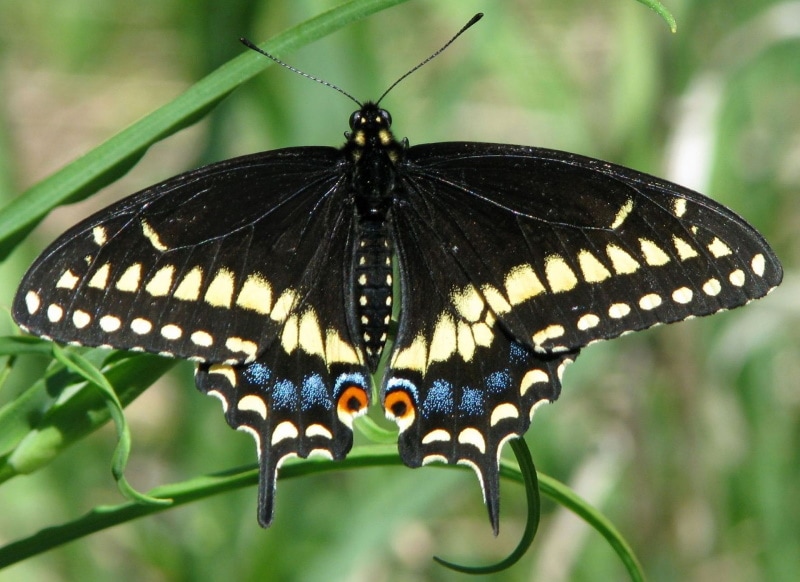
| Scientific name | Limenitis archippus |
| Wingspan | 3–4 inches |
The black swallowtail is one of the most widespread butterflies in the Eastern United States and is often a common inhabitant of Southern California yards and gardens. They are hard to miss with their size and vivid coloring! The butterflies have black wings with a pattern of yellow spots along the edges and blue and orange marks near the tail.
They also have the distinct double-pointed “swallowtail.” The caterpillars are green with black and yellow stripes. Unfortunately, they like to feed on garden plants and herbs.
Adults love colorful flowers, which is why they are often spotted around human homes and parks. Black swallowtails look similar to another species of butterfly that is toxic to predators, offering them protection from being eaten.
21. Coral Hairstreak
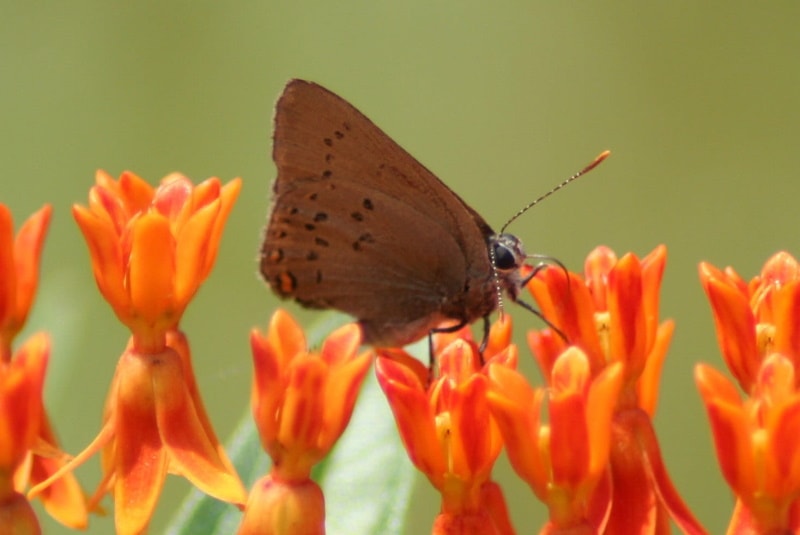
| Scientific name | Satyrium titus |
| Wingspan | 1–1.5 inches |
The coral hairstreak is found in the northeastern corner of California. It is a small butterfly with gray wings dotted with a line of bright orange spots along the edge. They live along forest edges, fields, or in brushy habitats.
The caterpillars feed on the wild cherry and wild plum family, primarily. They hide among fallen leaves on the ground during the day and climb up to eat at night. Adults drink nectar from various flowers, including milkweed.
Conclusion
Butterflies play a vital role in the ecosystem by serving as pollinators as well as a food source for other creatures. Some of the 21 California butterfly species on our list suffer from declining population numbers, including the famous monarch.
You can help support these species, and all butterflies, by growing flowers and other plants around your yard and garden. Also, avoid using chemical pesticides on your lawn or garden since many are toxic to butterflies.
See also:
- 21 Most Common Types of Butterflies in Hawaii
- 10 Most Common Butterflies in Oklahoma (With Pictures)
Featured Image Credit; emkaplin, Shutterstock
Contents


